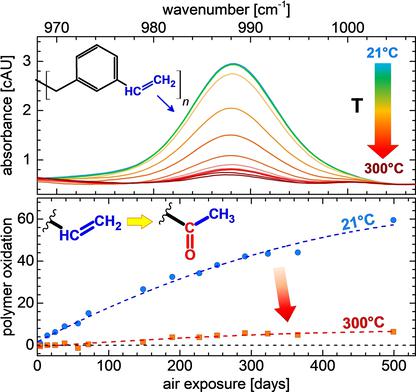当前位置:
X-MOL 学术
›
ChemistrySelect
›
论文详情
Our official English website, www.x-mol.net, welcomes your
feedback! (Note: you will need to create a separate account there.)
Enhancing the Oxidation Stability of Polydivinylbenzene Films via Residual Pendant Vinyl Passivation
ChemistrySelect ( IF 1.9 ) Pub Date : 2018-01-11 , DOI: 10.1002/slct.201702685 Xavier Lepró 1 , Paul Ehrmann 1 , Jennifer Rodríguez 1 , Salmaan Baxamusa 1
ChemistrySelect ( IF 1.9 ) Pub Date : 2018-01-11 , DOI: 10.1002/slct.201702685 Xavier Lepró 1 , Paul Ehrmann 1 , Jennifer Rodríguez 1 , Salmaan Baxamusa 1
Affiliation

|
Polydivinylbenzene (PDVB) is a thermally stable, optically transparent, crosslinked polymer that until recently has been difficult to synthesize as a thin film. With the recent demonstration of initiated chemical vapor deposition (iCVD) of thin PDVB films, a renewed interest in the material properties of PDVB has developed. In particular, attention is now focused on its oxidation pathways and long‐term stability under the desired application use conditions. Here, we report on the thermal and environmental stability of PDVB films and show that unreacted pendant vinyl groups drive polymer oxidation upon exposure to either air or light. We demonstrate that such vinyls can be effectively passivated by a simple ex‐situ thermal annealing at ca. 300 °C in inert atmosphere that induces an 87% reduction of the PDVB oxidation rate in air and slows light (λ=405 nm) induced oxidation by 56%. While the thermal annealing is less effective at preventing oxidation under higher energy (λ = 365 nm) UV light, we demonstrate that this aging pathway is based on the presence of reactive oxygen species rather than traditional photo‐oxidation. Vinyl removal through ex‐situ thermal annealing improves the chemical stability of iCVD PDVB to continuous air (over 500 days) or light (70 hours) exposure and offers a simple option to improve its environmental aging resistance which is important for long‐term protective applications.
中文翻译:

通过残留侧链乙烯基钝化增强聚二乙烯基苯薄膜的氧化稳定性
聚二乙烯基苯(PDVB)是一种热稳定,光学透明的交联聚合物,直到最近一直难以合成为薄膜。随着最近对薄PDVB薄膜的化学气相沉积(iCVD)的演示,人们对PDVB的材料性能有了新的兴趣。现在,尤其要注意的是其在所需应用使用条件下的氧化途径和长期稳定性。在这里,我们报道了PDVB薄膜的热稳定性和环境稳定性,并表明未反应的乙烯基侧基在暴露于空气或光线时会驱动聚合物氧化。我们证明了这种乙烯基可以通过一个简单的在约200摄氏度的易位热退火而被有效地钝化。惰性气体中的300°C可使空气中PDVB的氧化速率降低87%,并使光(λ= 405 nm)引起的氧化速度降低56%。尽管热退火在较高能量(λ= 365 nm)的紫外线下不能有效防止氧化,但我们证明了这种老化途径是基于活性氧的存在,而不是传统的光氧化作用。通过异位热退火除去乙烯基,提高了iCVD PDVB在连续空气(超过500天)或光照(70小时)下的化学稳定性,并提供了一种简单的选择来改善其耐环境老化性,这对于长期保护应用至关重要。我们证明了这种衰老途径是基于活性氧的存在,而不是传统的光氧化作用。通过异位热退火除去乙烯基,提高了iCVD PDVB在连续空气(超过500天)或光照(70小时)下的化学稳定性,并提供了一种简单的选择来改善其耐环境老化性,这对于长期保护应用至关重要。我们证明了这种衰老途径是基于活性氧的存在,而不是传统的光氧化作用。通过异位热退火除去乙烯基,提高了iCVD PDVB在连续空气(超过500天)或光照(70小时)下的化学稳定性,并提供了一种简单的选择来改善其耐环境老化性,这对于长期保护应用至关重要。
更新日期:2018-01-11
中文翻译:

通过残留侧链乙烯基钝化增强聚二乙烯基苯薄膜的氧化稳定性
聚二乙烯基苯(PDVB)是一种热稳定,光学透明的交联聚合物,直到最近一直难以合成为薄膜。随着最近对薄PDVB薄膜的化学气相沉积(iCVD)的演示,人们对PDVB的材料性能有了新的兴趣。现在,尤其要注意的是其在所需应用使用条件下的氧化途径和长期稳定性。在这里,我们报道了PDVB薄膜的热稳定性和环境稳定性,并表明未反应的乙烯基侧基在暴露于空气或光线时会驱动聚合物氧化。我们证明了这种乙烯基可以通过一个简单的在约200摄氏度的易位热退火而被有效地钝化。惰性气体中的300°C可使空气中PDVB的氧化速率降低87%,并使光(λ= 405 nm)引起的氧化速度降低56%。尽管热退火在较高能量(λ= 365 nm)的紫外线下不能有效防止氧化,但我们证明了这种老化途径是基于活性氧的存在,而不是传统的光氧化作用。通过异位热退火除去乙烯基,提高了iCVD PDVB在连续空气(超过500天)或光照(70小时)下的化学稳定性,并提供了一种简单的选择来改善其耐环境老化性,这对于长期保护应用至关重要。我们证明了这种衰老途径是基于活性氧的存在,而不是传统的光氧化作用。通过异位热退火除去乙烯基,提高了iCVD PDVB在连续空气(超过500天)或光照(70小时)下的化学稳定性,并提供了一种简单的选择来改善其耐环境老化性,这对于长期保护应用至关重要。我们证明了这种衰老途径是基于活性氧的存在,而不是传统的光氧化作用。通过异位热退火除去乙烯基,提高了iCVD PDVB在连续空气(超过500天)或光照(70小时)下的化学稳定性,并提供了一种简单的选择来改善其耐环境老化性,这对于长期保护应用至关重要。











































 京公网安备 11010802027423号
京公网安备 11010802027423号